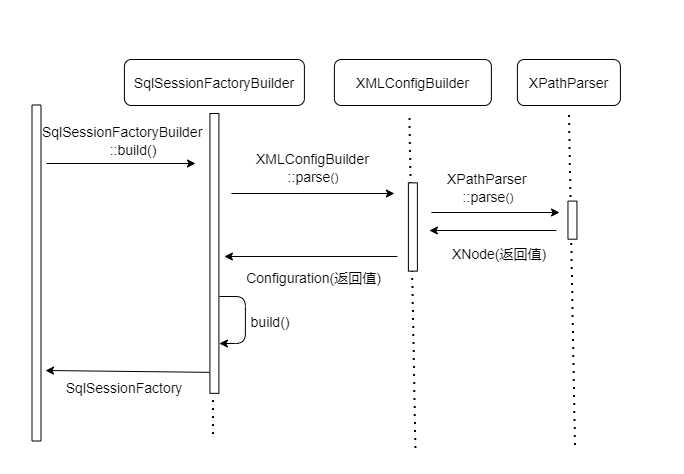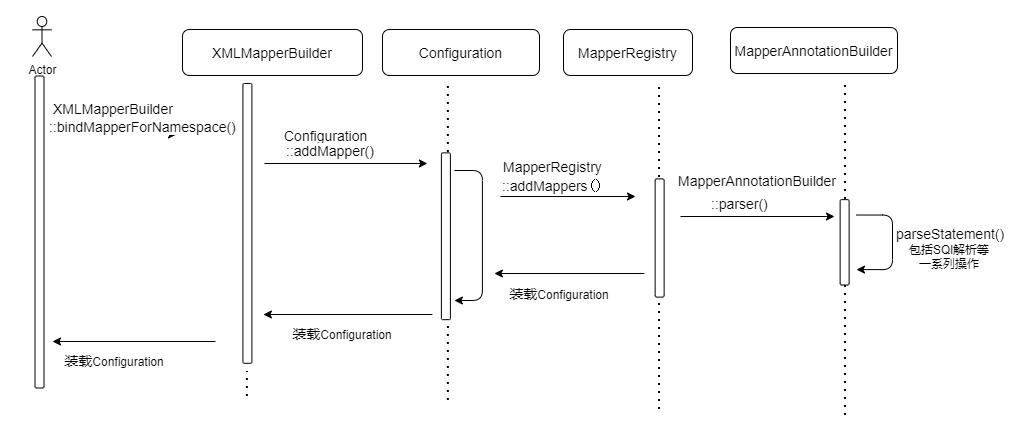MyBatis初始化
在 MyBatis 初始化过程中,会加载 mybatis-config.xml 配置文件、 Mapper.xml 映射配置文件以及
Mapper 接口中的注解信息,解析后的配置信息会形成相应的对象并保存到 Configuration 对象中。
初始化过程可以分成三部分:
- 解析 mybatis-config.xml 配置文件
- SqlSessionFactoryBuilder
- XMLConfigBuilder
- Configuration
- 解析 Mapper.xml 映射配置文件
- XMLMapperBuilder::parse()
- XMLStatementBuilder::parseStatementNode ()
- XMLLanguageDriver
- SqlSource
- MappedStatement
- 解析Mapper接口中的注解
- MapperRegistry
- MapperAnnotationBuilder::parse()
解析mybatis-config.xml 配置文件
MyBatis 的初始化流程的入口是 SqlSessionFactoryBuilder::build(Reader reader, String environment, Properties properties) 方法,看看具体流程图:
public SqlSessionFactory build(InputStream inputStream, String environment,Properties properties) {try {XMLConfigBuilder parser = new XMLConfigBuilder(inputStream, environment,properties);return build(parser.parse());} catch (Exception e) {throw ExceptionFactory.wrapException("Error building SqlSession.", e);} finally {ErrorContext.instance().reset();try {inputStream.close();} catch (IOException e) {// Intentionally ignore. Prefer previous error.}}}
首先会使用 XMLConfigBuilder::parser() 解析 mybatis-config.xml 配置文件,
- 先解析标签 configuration 内的数据封装成 XNode , configuration 也是 MyBatis 中最重要的一个标签
- 根据 XNode 解析 mybatis-config.xml 配置文件的各个标签转变为各个对象
private void parseConfiguration(XNode root) {try {//issue #117 read properties firstpropertiesElement(root.evalNode("properties"));Properties settings = settingsAsProperties(root.evalNode("settings"));loadCustomVfs(settings);typeAliasesElement(root.evalNode("typeAliases"));pluginElement(root.evalNode("plugins"));objectFactoryElement(root.evalNode("objectFactory"));objectWrapperFactoryElement(root.evalNode("objectWrapperFactory"));reflectorFactoryElement(root.evalNode("reflectorFactory"));settingsElement(settings);// read it after objectFactory and objectWrapperFactory issue #631environmentsElement(root.evalNode("environments"));databaseIdProviderElement(root.evalNode("databaseIdProvider"));typeHandlerElement(root.evalNode("typeHandlers"));mapperElement(root.evalNode("mappers"));} catch (Exception e) {throw new BuilderException("Error parsing SQL Mapper Configuration. Cause:" + e, e);}}
再基于 Configuration 使用 SqlSessionFactoryBuilder::build() 生成DefaultSqlSessionFactory 供给后续执行使用。
解析Mapper.xml映射配置文件
首先使用 XMLMapperBuilder::parse() 解析 Mapper.xml ,看看加载流程图来分析分析
通过 XPathParser::evalNode 将 mapper 标签中内容解析到 XNode
public void parse() {if (!this.configuration.isResourceLoaded(this.resource)) {this.configurationElement(this.parser.evalNode("/mapper"));this.configuration.addLoadedResource(this.resource);this.bindMapperForNamespace();}this.parsePendingResultMaps();this.parsePendingCacheRefs();this.parsePendingStatements();}
再由 configurationElement() 方法去解析 XNode 中的各个标签:
- namespace
- parameterMap
- resultMap
- select|insert|update|delete
private void configurationElement(XNode context) {try {String namespace = context.getStringAttribute("namespace");if (namespace == null || namespace.equals("")) {throw new BuilderException("Mapper's namespace cannot be empty");}builderAssistant.setCurrentNamespace(namespace);cacheRefElement(context.evalNode("cache-ref"));cacheElement(context.evalNode("cache"));parameterMapElement(context.evalNodes("/mapper/parameterMap"));resultMapElements(context.evalNodes("/mapper/resultMap"));sqlElement(context.evalNodes("/mapper/sql"));//解析MapperStatebuildStatementFromContext(context.evalNodes("select|insert|update|delete"));} catch (Exception e) {throw new BuilderException("Error parsing Mapper XML. The XML location is'" + resource + "'. Cause: " + e, e);}}
其中,基于 XMLMapperBuilder::buildStatementFromContext() ,遍历 、 、 、 节点们,逐个创
建 XMLStatementBuilder 对象,执行解析,通过 XMLStatementBuilder::parseStatementNode() 解
析,
- parameterType
- resultType
- selectKey 等
并会通过 LanguageDriver::createSqlSource() (默认 XmlLanguageDriver )解析动态sql生成
SqlSource (详细内容请看下个小节),
- 使用 GenericTokenParser::parser() 负责将 SQL 语句中的 #{} 替换成相应的 ? 占位符,并获取该 ? 占位符对应的
而且通过 MapperBuilderAssistant::addMappedStatement() 生成 MappedStatement
public void parseStatementNode() {//获得 id 属性,编号String id = context.getStringAttribute("id");String databaseId = context.getStringAttribute("databaseId");// 判断 databaseId 是否匹配if (!databaseIdMatchesCurrent(id, databaseId, this.requiredDatabaseId)) {return;}//解析获得各种属性Integer fetchSize = context.getIntAttribute("fetchSize");Integer timeout = context.getIntAttribute("timeout");String parameterMap = context.getStringAttribute("parameterMap");String parameterType = context.getStringAttribute("parameterType");Class<?> parameterTypeClass = resolveClass(parameterType);String resultMap = context.getStringAttribute("resultMap");String resultType = context.getStringAttribute("resultType");String lang = context.getStringAttribute("lang");//获得 lang 对应的 LanguageDriver 对象LanguageDriver langDriver = getLanguageDriver(lang);//获得 resultType 对应的类Class<?> resultTypeClass = resolveClass(resultType);String resultSetType = context.getStringAttribute("resultSetType");//获得 statementType 对应的枚举值StatementType statementType =StatementType.valueOf(context.getStringAttribute("statementType",StatementType.PREPARED.toString()));//获得 resultSet 对应的枚举值ResultSetType resultSetTypeEnum = resolveResultSetType(resultSetType);String nodeName = context.getNode().getNodeName();//获得 SQL 对应的 SqlCommandType 枚举值SqlCommandType sqlCommandType =SqlCommandType.valueOf(nodeName.toUpperCase(Locale.ENGLISH));boolean isSelect = sqlCommandType == SqlCommandType.SELECT;//解析获得各种属性boolean flushCache = context.getBooleanAttribute("flushCache", !isSelect);boolean useCache = context.getBooleanAttribute("useCache", isSelect);boolean resultOrdered = context.getBooleanAttribute("resultOrdered", false);//创建 XMLIncludeTransformer 对象,并替换 <include /> 标签相关的内容XMLIncludeTransformer includeParser = new XMLIncludeTransformer(configuration,builderAssistant);includeParser.applyIncludes(context.getNode());//解析 <selectKey /> 标签processSelectKeyNodes(id, parameterTypeClass, langDriver);//创建 SqlSource生成动态sqlSqlSource sqlSource = langDriver.createSqlSource(configuration, context,parameterTypeClass);String resultSets = context.getStringAttribute("resultSets");String keyProperty = context.getStringAttribute("keyProperty");String keyColumn = context.getStringAttribute("keyColumn");KeyGenerator keyGenerator;String keyStatementId = id + SelectKeyGenerator.SELECT_KEY_SUFFIX;keyStatementId = builderAssistant.applyCurrentNamespace(keyStatementId, true);if (configuration.hasKeyGenerator(keyStatementId)) {keyGenerator = configuration.getKeyGenerator(keyStatementId);} else {keyGenerator = context.getBooleanAttribute("useGeneratedKeys",configuration.isUseGeneratedKeys() &&SqlCommandType.INSERT.equals(sqlCommandType))? Jdbc3KeyGenerator.INSTANCE : NoKeyGenerator.INSTANCE;}//创建 MappedStatement 对象this.builderAssistant.addMappedStatement(id, sqlSource, statementType,sqlCommandType, fetchSize, timeout, parameterMap,parameterTypeClass,resultMap, resultTypeClass, resultSetTypeEnum, flushCache,useCache, resultOrdered, (KeyGenerator)keyGenerator,keyProperty,keyColumn, databaseId, langDriver, resultSets);}
解析Mapper接口中的注解
当执行完 XMLMapperBuilder::configurationElement() 方法后,会调用XMLMapperBuilder::bindMapperForNamespace() 会转换成对接口上注解进行扫描,具体通过MapperRegistry::addMapper() 调用 MapperAnnotationBuilder 实现的

MapperAnnotationBuilder::parse() 是注解构造器,负责解析 Mapper 接口上的注解,解析时需要注意避免和 XMLMapperBuilder::parse() 方法冲突,重复解析,最终使用 parseStatement 解析,那怎么操作?
public void parse() {String resource = type.toString();//判断当前 Mapper 接口是否应加载过。if (!configuration.isResourceLoaded(resource)) {//加载对应的 XML Mapper,注意避免和 `XMLMapperBuilder::parse()` 方法冲突loadXmlResource();//标记该 Mapper 接口已经加载过configuration.addLoadedResource(resource);assistant.setCurrentNamespace(type.getName());//解析 @CacheNamespace 注解parseCache();parseCacheRef();//遍历每个方法,解析其上的注解Method[] methods = type.getMethods();for (Method method : methods) {try {if (!method.isBridge()) {//执行解析parseStatement(method);}} catch (IncompleteElementException e) {configuration.addIncompleteMethod(new MethodResolver(this, method));}}}//解析待定的方法parsePendingMethods();}
那其中最重要的 parseStatement() 是怎么操作?其实跟解析 Mapper.xml 类型主要处理流程类似:
- 通过加载LanguageDriver , GenericTokenParser 等为生成 SqlSource 动态sql作准备
- 使用MapperBuilderAssistant::addMappedStatement() 生成注解@mapper , @CacheNamespace 等的 MappedStatement 信息
void parseStatement(Method method) {//获取接口参数类型Class<?> parameterTypeClass = getParameterType(method);//加载语言处理器,默认XmlLanguageDriverLanguageDriver languageDriver = getLanguageDriver(method);//根据LanguageDriver,GenericTokenParser生成动态SQLSqlSource sqlSource = getSqlSourceFromAnnotations(method,parameterTypeClass, languageDriver);if (sqlSource != null) {//获取其他属性Options options = method.getAnnotation(Options.class);final String mappedStatementId = type.getName() + "." +method.getName();Integer fetchSize = null;Integer timeout = null;StatementType statementType = StatementType.PREPARED;ResultSetType resultSetType = null;SqlCommandType sqlCommandType = getSqlCommandType(method);boolean isSelect = sqlCommandType == SqlCommandType.SELECT;boolean flushCache = !isSelect;boolean useCache = isSelect;//获得 KeyGenerator 对象KeyGenerator keyGenerator;String keyProperty = null;String keyColumn = null;if (SqlCommandType.INSERT.equals(sqlCommandType) ||SqlCommandType.UPDATE.equals(sqlCommandType)) { // 有// first check for SelectKey annotation - that overrides everythingelse//如果有 @SelectKey 注解,则进行处理SelectKey selectKey = method.getAnnotation(SelectKey.class);if (selectKey != null) {keyGenerator = handleSelectKeyAnnotation(selectKey,mappedStatementId, getParameterType(method), languageDriver);keyProperty = selectKey.keyProperty();//如果无 @Options 注解,则根据全局配置处理} else if (options == null) {keyGenerator = configuration.isUseGeneratedKeys() ?Jdbc3KeyGenerator.INSTANCE : NoKeyGenerator.INSTANCE;// 如果有 @Options 注解,则使用该注解的配置处理} else {keyGenerator = options.useGeneratedKeys() ?Jdbc3KeyGenerator.INSTANCE : NoKeyGenerator.INSTANCE;keyProperty = options.keyProperty();keyColumn = options.keyColumn();}// 无} else {keyGenerator = NoKeyGenerator.INSTANCE;}//初始化各种属性if (options != null) {if (FlushCachePolicy.TRUE.equals(options.flushCache())) {flushCache = true;} else if (FlushCachePolicy.FALSE.equals(options.flushCache())) {flushCache = false;}useCache = options.useCache();fetchSize = options.fetchSize() > -1 || options.fetchSize() ==Integer.MIN_VALUE ? options.fetchSize() : null; //issue #348timeout = options.timeout() > -1 ? options.timeout() : null;statementType = options.statementType();resultSetType = options.resultSetType();}// 获得 resultMapId 编号字符串String resultMapId = null;//如果有 @ResultMap 注解,使用该注解为 resultMapId 属性ResultMap resultMapAnnotation = method.getAnnotation(ResultMap.class);if (resultMapAnnotation != null) {String[] resultMaps = resultMapAnnotation.value();StringBuilder sb = new StringBuilder();for (String resultMap : resultMaps) {if (sb.length() > 0) {sb.append(",");}sb.append(resultMap);}resultMapId = sb.toString();// 如果无 @ResultMap 注解,解析其它注解,作为 resultMapId 属性} else if (isSelect) {resultMapId = parseResultMap(method);}//构建 MappedStatement 对象assistant.addMappedStatement(mappedStatementId,sqlSource,statementType,sqlCommandType,fetchSize,timeout,// ParameterMapIDnull,parameterTypeClass,resultMapId,getReturnType(method),resultSetType,flushCache,useCache,// TODO gcode issue #577false,keyGenerator,keyProperty,keyColumn,// DatabaseIDnull,languageDriver,// ResultSetsoptions != null ? nullOrEmpty(options.resultSets()) : null);}}
生成动态SqlSource
当在执行 langDriver::createSqlSource(configuration, context, parameterTypeClass) 中的时候, 是怎样从 Mapper XML 或方法注解上读取 SQL 内容生成动态 SqlSource 的呢?现在来一探究竟,
首先需要获取 langDriver 实现 XMLLanguageDriver / RawLanguageDriver ,现在使用默认的XMLLanguageDriver::createSqlSource(configuration, context, parameterTypeClass) 开启创建,再使用 XMLScriptBuilder::parseScriptNode() 解析生成 SqlSource
- DynamicSqlSource : 动态的 SqlSource 实现类 , 适用于使用了 OGNL 表达式,或者使用了${} 表达式的 SQL
- RawSqlSource : 原始的 SqlSource 实现类 , 适用于仅使用 #{} 表达式,或者不使用任何表达式的情况
public SqlSource parseScriptNode() {MixedSqlNode rootSqlNode = this.parseDynamicTags(this.context);Object sqlSource;if (this.isDynamic) {sqlSource = new DynamicSqlSource(this.configuration, rootSqlNode);} else {sqlSource = new RawSqlSource(this.configuration, rootSqlNode,this.parameterType);}return (SqlSource)sqlSource;}
那就选择其中一种来分析一下 RawSqlSource ,怎么完成构造的呢?看看 RawSqlSource 构造函数:
public RawSqlSource(Configuration configuration, String sql, Class<?>parameterType) {SqlSourceBuilder sqlSourceParser = new SqlSourceBuilder(configuration);Class<?> clazz = parameterType == null ? Object.class : parameterType;this.sqlSource = sqlSourceParser.parse(sql, clazz, new HashMap());}
使用 SqlSourceBuilder::parse() 去解析SQl,里面又什么神奇的地方呢?
public SqlSource parse(String originalSql, Class<?> parameterType, Map<String,Object> additionalParameters) {SqlSourceBuilder.ParameterMappingTokenHandler handler = newSqlSourceBuilder.ParameterMappingTokenHandler(this.configuration, parameterType,additionalParameters);//创建基于#{}的GenericTokenParserGenericTokenParser parser = new GenericTokenParser("#{", "}", handler);String sql = parser.parse(originalSql);return new StaticSqlSource(this.configuration, sql,handler.getParameterMappings());}
ParameterMappingTokenHandler 是 SqlSourceBuilder 的内部私有静态类,ParameterMappingTokenHandler ,负责将匹配到的 #{ 和 } 对,替换成相应的 ? 占位符,并获取
该 ? 占位符对应的 org.apache.ibatis.mapping.ParameterMapping 对象。
并基于 ParameterMappingTokenHandler 使用 GenericTokenParser::parse() 将SQL中的 #{} 转化占位符 ? 占位符后创建一个 StaticSqlSource 返回。
总结
在 MyBatis 初始化过程中,会加载 mybatis-config.xml 配置文件、 Mapper.xml 映射配置文件以及Mapper 接口中的注解信息,解析后的配置信息会形成相应的对象并全部保存到 Configuration 对象中,并创建 DefaultSqlSessionFactory 供SQl执行过程创建出顶层接口 SqlSession 供给用户进行操作。

